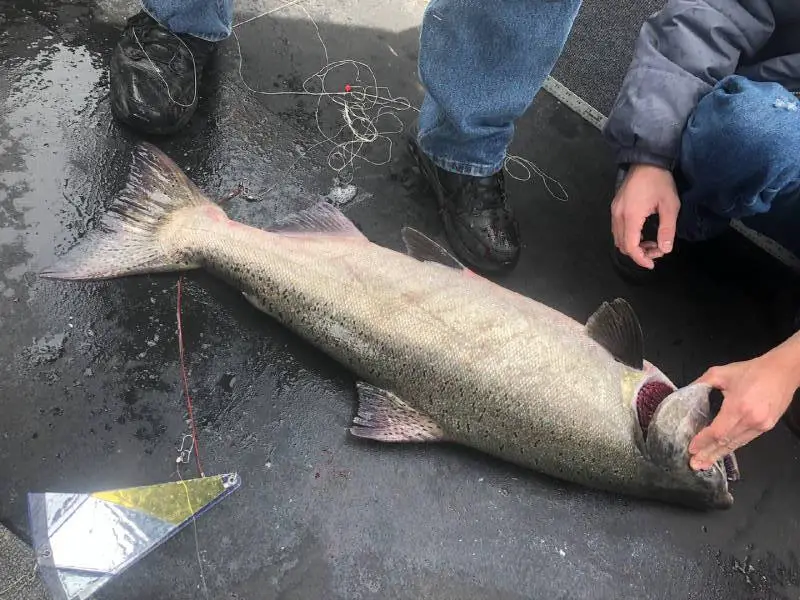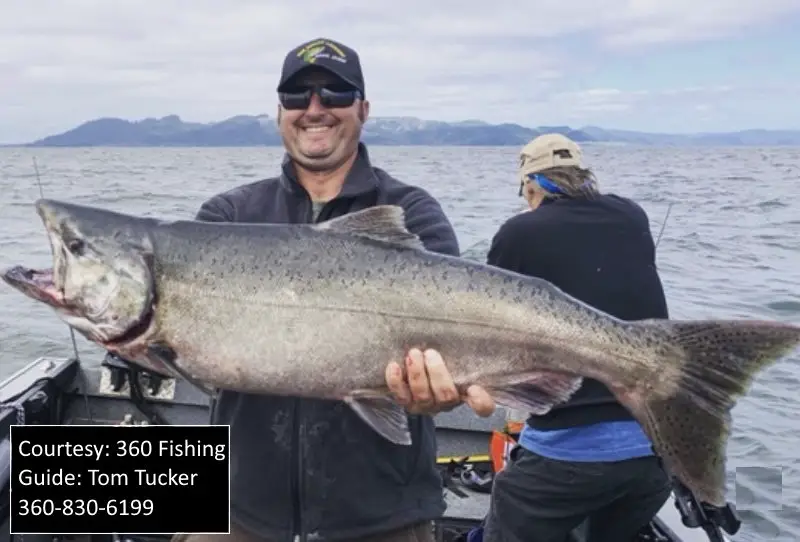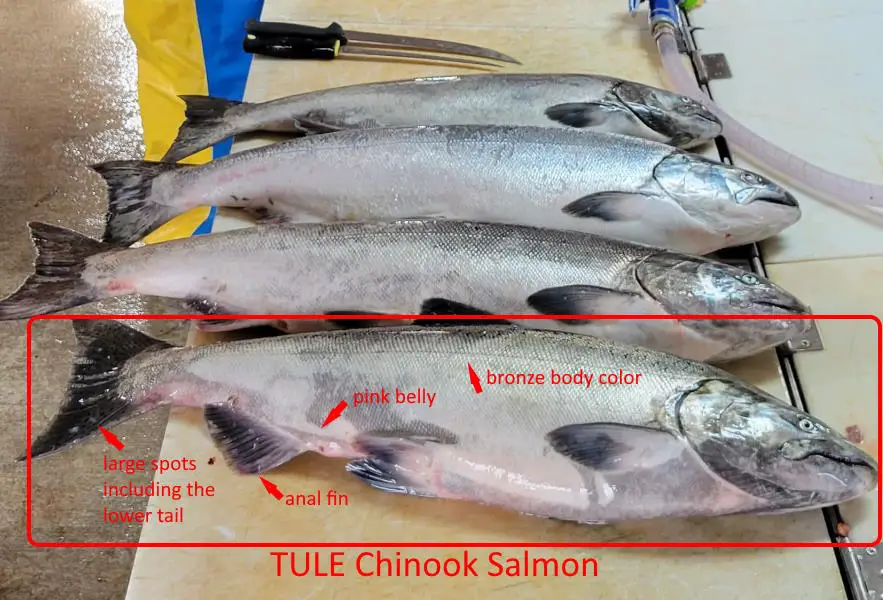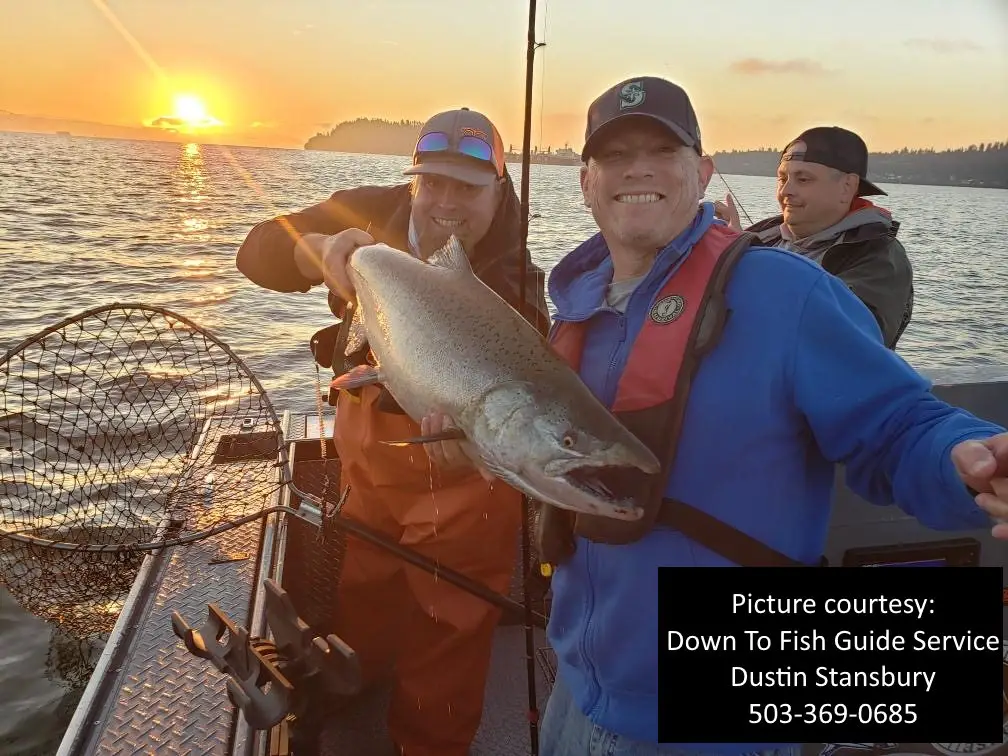Everyone wants to catch a huge chinook salmon, but not all salmon are created equally. Also, from year-to-year different species of fish could have low population counts that affect what you can catch and when you can fish.
In recent years the wild Tule is frequently one of the fish species of Chinook salmon that have a major impact on the fishing season and in-season regulations. So, identifying a Tule Chinook Salmon and releasing it unharmed is very important to keep the season open in affected areas.
In this article, we are going to talk about the Tule Chinook Salmon species, why you want to release them, and 7 ways to identify them.

What is a Tule Chinook Salmon?
Tule Chinook Salmon are a lower Columbia River species. They return to their point of origin in the early fall, typically between August 1st and September 1st.
These salmon start their life in multiple locations in the lower Columbia River, most below the Bonneville Dam. Some Tule Salmon are wild stocks, but a larger percentage are of hatchery origin.
The fish leave the Columbia and migrate north up the Pacific Ocean coast to Alaska waters. After four years, the Tule Chinook migrate back to their point of origin in the Columbia River tributary system to spawn.
Many Salmon will tend not to be aggressive once they leave the saltwater, making them hard for fishermen to catch. However, these Chinook tend to be particularly aggressive and exert more energy when caught.
Why Release Tule Chinook Salmon?
Tule Chinook Salmon are considered to be an at-risk population because of dams, harvest (commercial and recreational), habitat degradation, and predation from sea lions, seals, and various birds. If Tule Salmon returns are low, then this could impact future salmon fishing.
NOAA Fisheries manages the fish through a program called Abundance-based management. This program tries to balance the factors that can affect the in-season and future fish stock.
By tracking in-season commercial and sports catch, NOAA can adjust the regulations to protect the wild Tule runs. One of the easiest mitigation efforts is to close salmon fishing seasons.
For this reason alone, releasing all wild Tule Chinook Salmon will help prevent premature fishing closures. However, another good reason to release Tules is poor-quality meat.
Because Tule Chinook Salmon are lower river fish, most of this strain is ready to spawn as soon as they arrive at their tributary of origin. These fish have biological changes that manifest in a poorer quality of fish.
As a salmon gets closer, it will divert its energy stores for reproductive functions. This transformation is more noticeable in females but also very noticeable in low river males.
Now not every Tule is a “boot,” but it is closer to a 60/40 chance. If the “boot” you take home was the one that put fishing over the limit, would it be worth it?

Ways to Identify Tule Chinook Salmon
Identifying a Tule is not always the easiest thing to do. First, check your fishing regulations every morning before hitting the water for any in-season changes.
As a rule of thumb, you should always avoid retaining wild Tule Chinook regardless if it is legal to retain them. Any wild fish can be identified by an intact adipose fin. If a fish is missing the adipose fin and the area is fully healed, it is a hatchery fish.
There are some hatchery fish with different fins clipped but know your regulations to avoid a ticket. Below we are going to list the features we use to identify Tules in our order of priority.
Large rounded anal fin – Tules have round anal fins that have ribs pointing at a steeper downward angle. The fin also appears more translucent and usually has pink where it is attached to the body.
Bronze color body – Most Tules have a bronze color to their body, with the upper body being olive green. This is not 100%, but it is rare for Tules to be dime bright or silver in appearance.
Large black spots – Spots on Tules are larger than other strains of salmon and usually run down the entire tail. Also, the tail on a Tule salmon is larger in proportion to other salmon, typically taller than the head.
Football-shaped body – most salmon have sleek bodies, but Tules are thicker in the middle and have a noticeable bump on the head.
Pink belly – Also Known as belly burn Tule Salmon can have pink on their bellies. This color is the same as the color at the base of the anal fin.
Old fish smell – Because Tules are closer to the end of their life cycle, they will have a strong fishy smell. The smell is similar to something you will smell on spawning beds where fish are spawned out and dying.
Slimy coating – Most Tules are slimy, and some are very slimy. Do not get this slime on you or your boat because it can be very stinky.

Additionally, you will see some features of salmon turning to the spawning phase. In the picture above you can see the mouth is not a straight line and the teeth become more prononced.
Keep in mind that if the chinook is a dark hatchery fish, there is a good chance it is not a Tule. If you catch one of these fish you should keep it to help prevent hatchery fish from straying on the spawning beds. Check out the video below, at 3:20 Cody show a dark fish that is not a Tule Chinook.
Other Fall Salmon
You might encounter a few different types and strains of salmon in the lower Columbia River. On August 1st, you have a good chance of encountering just about every possible variety of salmon and summer steelhead.
Salmon Types and Strains in the Lower Columbia River
- Spring Chinook
- Summer Chinook
- Sockeye
- Fall Tule Chinook
- Up River Brights
- Coho
Final Thoughts
Wild Tule Chinook salmon are a very limited stock. If this stock is short, then fishing opportunities will be limited.
So, consider releasing every Tule, as this will reduce the impact. We will get the most out of our fishing seasons if everyone does their part.

Resources
For a great video that shows a Tule Chinook Salmon caught and released, take a look at this video starting at 4:30. The fisherman in this video is a master, and the whole video is a great watch.
This link will take you to an ODFW flyer archived on the Oregonlive website for Tule Salmon identification. I don’t think the resolution is good enough to print, but you could link it on your cell phone.



